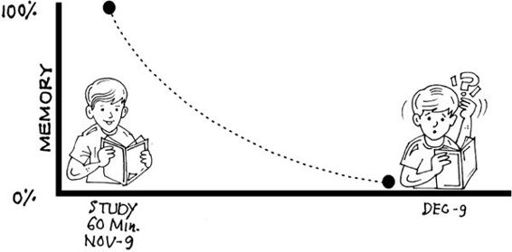How to Memorize Anything (38 page)
Read How to Memorize Anything Online
Authors: Aditi Singhal,Sudhir Singhal
Tags: #Self-Help, #Meditations

By the 1980s, several political organizations were formed demanding an independent Tamil Elam in northern and eastern parts of Sri Lanka. The distrust between two communities turned into widespread conflict. It soon turned into a
civil war
. As a result
thousands
of
people
of both the communities have been
killed
. Many
families
were forced to
leave
the country as
refugees
and many more
lost
their
livelihoods
.

*
see
appendix II
'mind maps' for colourful image of the above mind map
USE MEMORY TECHNIQUES
As students, we all have to remember a lot of theory and complex numerical data. Although some people might be good at mugging up, such practices yield no result in the long run. Instead if we convert this information into meaningful images, it will be easy to memorize it through associations and will stay with us for a longer period of time.
In the previous chapters we have learnt this art of using memory techniques through various methods. In the student section you will find various ways of applying these techniques in different areas of your course. Though the techniques and methods can be applied according to your ease and understanding, here is a brief summary of the methods with their suggested application in the table below:
| S. NO. | MEMORY METHOD | APPLICATION |
|---|---|---|
| 1. | Chain Method | Points in sequence, short answers in points, keywords of long answers, classifications, etc. |
| 2. | Hide-and-Seek Method | Speech, points of presentations, list of words, answers in points, long answers in detail, etc. |
| 3. | PNN (Personal Nick Name) | Scientific terminology, abstract information, vocabulary, foreign language, general knowledge facts, historical names, etc. |
| 4. | Peg Method | Number sequences, constants, melting point, boiling point, periodic table, valancies, history dates, square roots, cube roots, etc. |
| 5. | Acronyms | Long names, list or any collection of words, technical and scientific information (list of bones, nerves in medicine), etc. |
| 6. | Acrostics | Data of upto 10 words in specific order, trigonometry formula, taxonomy in biology, spellings, steps in a process, types of information, etc. |
SCIENTIFIC REVISION PLAN
WHY TO REVISE?
Downloaded from GAPPAA.ORG - No.1 Desi Ebook Site, It's FREE.
The revision period is, arguably, the most difficult part of any exam process, yet it is an important and unavoidable step.
Imagine you are passing through a dense forest. On the first day, the path is full of wild bushes and you find it extremely difficult to pass through. But instead of giving up, you clear the bushes and make a way to cross it. It was hard work and took a lot of time. But the next day, when you take the same route, it becomes a little easier as you push back more of the branches. Gradually, day by day, a clear path emerges.
Learning is a lot like that:
repetition gradually strengthens your memory pathways
. The more times you travel the same routes, the stronger the memory gets. If you only experience something once, and don’t think about it again, it will almost certainly be forgotten.
WHEN TO REVISE?
Most information we take in through our senses is forgotten very quickly. There is a mechanism which must be activated if a memory is to go into a long-term store.
A nineteenth century German psychologist caller
Hermann Ebbinghaus
discovered that forgetting follows an exponential slope. In other words, the sharpest drop in our memory of something occurs nearest to the time we experience it, but then the drop off evens out.
This means that the first hours and days are the most important time for reviewing new information you want to remember in the long term. The younger a memory, the more vulnerable and weak it is.
Imagine each memory as a sick newborn kitten. If you can just nurse it through it’s first 24 hours, then its chances of survival double. If you can nurse it through its first week, its chances double again, and after that it will only required attention now and then in order to survive.
If you think that once you are thorough with the concept, you can revise it only at the time of exam, you are highly mistaken. Look at the curve of forgetting given below.
CURVE OF FORGETTING

CURVE OF FORGETTING

The graph above clearly shows that if you are revising something regularly, you
need just 5 minutes to refresh your memory after a month
to recall the details, whereas if you do not revise the topic, you will be completely blank when you will refer to it after a month.
Here is suggested schedule for reviewing information you want to store in long-term memory:
- one hour,
- one day,
- one week,
- one month,
- one season (three months)
- one year
Student may argue that revising a topic or chapter so many times is very time consuming and impractical. This may be because they read whole answers or chapters again and again from the book itself, whereas reading the whole chapter is required only in the beginning to understand. After that, if a student prepares notes by focusing on the keywords or important points from the subject matter, revising those notes becomes very easy.
Besides this, revision takes only 10 percent of the first learning time, if done within 24 hours, i.e. if you memorize something in 60 minutes, you will take around 5–6 minutes to revise the same.
Though exams bring with them a lot of stress, knowing that you have revised everything as planned brings relief and self-confidence.
BEWARE OF: PROCRASTINATION AND DISTRACTION
Procrastination is an act or a habit of putting off things for a later time. All human beings face this problem at some time or the other. We waste our time in doing less urgent tasks in place of urgent ones.
Today’s age of high-end gadgets and technology plus exposure to ‘n’ number of means of entertainment adds to this habit. Once you switch on the
TV
to take a break of 15 minutes from your studies, you will not even realize that you spent an hour surfing on various channels, thus wasting your time and energy.
WhatsApp, Facebook, Hike
and other similar social networking platforms give you an excuse to procrastinate your studies. No matter what time it is, replying to your friend’s message seems more important than completing the topic at hand.

Every problem has a solution. This problem of procrastination can be solved in four simple yet important steps.
- Admit it:
Admit that you have a problem of procrastination, only then will you look for solutions. - List:
Make a list of all the excuses you make to avoid doing work and then confront them with a positive mind.EXCUSE REALISTIC THOUGHT The topic is too long. I will do it later. I will divide the topic in parts and start by taking up one part at a time. Right now is not the perfect time to start. I feel so energetic that I feel this is the right time to start. I will do it early morning. I will finish it now so that I can sleep without any tension and start something fresh tomorrow morning. - Affirmations:
Affirmations are positive thoughts that we should keep giving ourselves as motivation. Just admitting that you’re lazy will not help. Give yourself affirmations such as:
‘I know that I have the skills
, resources, and energy to get my to-do list done’.‘I choose to be a productive person.’
‘I believe in the effort I make. I know that my work will generate results. ’
- Accountability and reward:
When you have decided to do a task, you must also decide the result of not doing it as well as the reward for accomplishing it. For example, if you have planned to finish a chapter of Geography by 5 o’clock in the evening, plan how you will reward yourself if you are able to do it on time. You could reward yourself with a game of badminton with friends or a visit to a nearby market etc. Then you should also decide the result of not completing the task like missing the movie you planned to watch the next day or getting up one hour early to finish the topic etc.
Just make sure that the reward is motivating as well as realistic so that you feel like meeting the deadline.
EXAM TIPS: NO FEAR, NOW THAT EXAMS ARE HERE!
When you are preparing for an exam:
- Review all the new material daily and weekly.
- Understand the content fully instead of just memorizing it.
- Link new material to previously learned material.
- Frequently test yourself on your knowledge of the material.
One to two weeks before the exam:
- Prioritize your course material on the basis of previous exams or practice papers.
- Ask your teacher what the exam format will be (e.g. multiple choice, short answer).
- Do a 30-minute overview of each course.
- Create review tools such as checklists, summaries, flash cards, or mock exams.
- Plan a realistic schedule for each exam and prioritize according to the exam’s weightage and difficulty, as well as how you are doing in the course.
